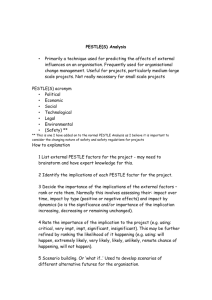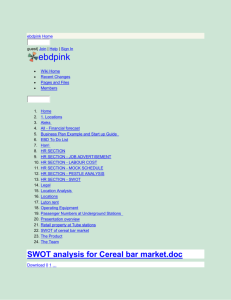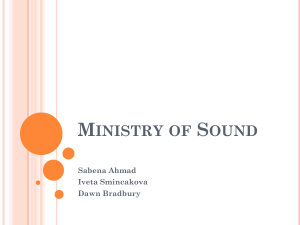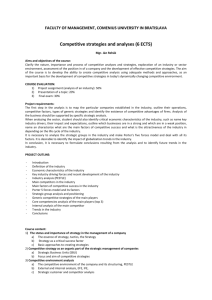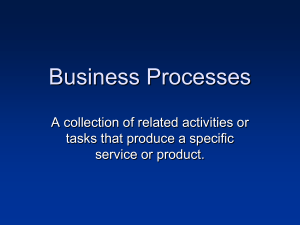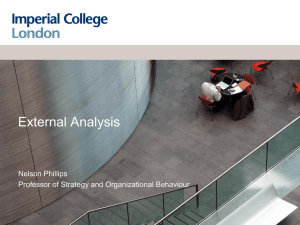Corporate Finance - Banks and Markets
advertisement
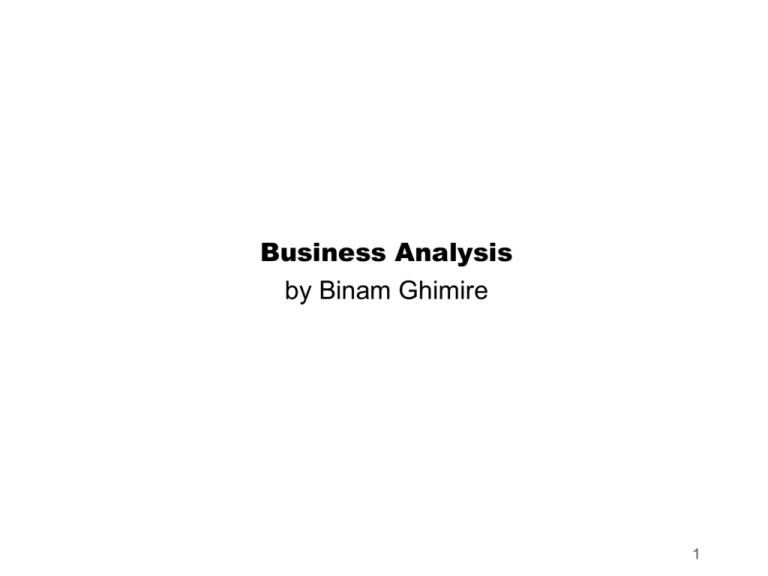
Business Analysis by Binam Ghimire 1 Learning Objectives 1. Internal and External Analysis; 2. PESTLE Analysis - an examination of the Legal, Economic, Political, Environmental; Social; Technological; Ethical factors and Competition. 3. SWOT Analysis - identifying and analysing Strengths, Weaknesses, Opportunities and Threats; 4. Porter's 5 Forces - Rivalry amongst Existing Competitors, New Entrants, Substitutes, Bargaining Powers of Buyers and Suppliers. Business & Financial Analysis Introduction As the course title suggests this course will examine: Business Analysis and Financial Analysis What do they involve ? Business Analysis Business Analysis involves: Internal Analysis – value chain, audit External Analysis – SWOT, PESTLE & Porter’s 5 Forces Model Competitive Advantage – Generic Strategies and SPACE Model, Stakeholder Analysis and Choices This session will focus on External Analysis (Internal Analysis: Self study) SWOT PESTLE Porter’s 5 Forces Model External Analysis SWOT PESTLE Porter’s 5 Forces Model Spend a moment outlining what you know of each model OK, let’s see if we agree… SWOT Analysis SWOT Strengths Internal Factors Weaknesses Opportunities External Factors (PESTLE Analysis) Threats SWOT Analysis Opportunities & Threats PESTLE Analysis is a useful tool to help identify Opportunities & Threats facing your organisation or sector Let us examine PESTLE Analysis… PESTLE Analysis PESTEL analysis is: an evaluation of broad societal trends that affect many industries. It is intended to identify: both current and, especially, future developments that will shape the micro-environments of each industry sector What current and future developments will have an impact on a particular sector ? Hint: The first one is P – Political. The second is E… PESTLE Factors POLITICAL ISSUES/TRENDS ECONOMIC ISSUES/TRENDS SOCIAL ISSUES/TRENDS TECHNOLOGICAL ISSUES/TRENDS ENVIRONMENTAL ISSUES/TRENDS LEGAL ISSUES/TRENDS PESTLE & The Oil Sector Spend a moment listing events under each heading with reference to the Oil Sector, for example: P – Political Tension in the Middle East may impact on supply and hence price Tension between neighbouring countries may affect supply, e.g. Russia and Ukraine Tax will affect price What did you come up with ? E Economic Volatility in the price of oil Exchange rate risk (oil is priced in $) Cost of petrol and its impact on demand Social The rise of the car from luxury to necessity Move to green and/or alternative fuel Technology Development of alternative energy due to….? Environmental BP Oil Spill Legal A good PESTLE analysis should be…. Focused on society wide trends which looks at the impact on industry and organisation. Based on sound research of actual (not hypothetical) issues. Supported by evidence from the research to validate points made. Future oriented rather than merely describing the present, i.e. it is about emerging trends that will shape the industries future. Interpretive in nature not descriptive, i.e. don’t just state what is, but say why/how it is significant for the future of the industry and firm context. Porter’s 5 Forces Model Industry Sector Analysis The industry analysis can be done using Porter’s 5 Forces Model. This has two main aims: 1.To understand the drivers of competitive behaviour in the sector; 2.To evaluate the long-run profit potential of the sector; What factors do you think drive Competitive Behaviour ? Porter’s 5 Forces Model Threat of new entrants Bargaining power of suppliers Again, consider the Oil Sector Rivalry among Existing firms Threat from Substitutes Bargaining Power of consumers • • • • • • • • • Capital requirements Product differentiation Switching costs Access to distribution channels Access to raw materials Intellectual property Competitive response Government regulation Economies of scale Bargaining power of Suppliers • • • • • • • Size of purchases Undifferentiated product Per cent of cost Low margins (buyer) Threat of forward integration Impact on quality Price performance is high Threat from new entrants • • • • • Size of purchases Differentiation in product Few substitutes A few big suppliers Threat of backward integration Intensity of Rivalry • Growth rate of market • Relative size of rivals • Capacity increases in large increments • Exit barriers are high • Switching costs • Profitability Threat of Substitute products Bargaining power of Customers • Degree of differentiation • Technological innovation • Price performance relationships Evaluation of the Five Force Model ADVANTAGES Identifies drivers of competitive behaviour. Indicates trends in profitability. Highlights strategies to alter industry structure. Can be used to compare attractiveness of different sectors. DISADVANTAGES Assumes all business relationships are competitive. Industry convergence makes defining sectors difficult. Five forces may not capture the whole picture of what drives an industry. Market analysis for strategy Market analysis for strategy purposes is not simply about customer segments, their needs and numbers as in marketing. Strategists are concerned with broader criteria relating to*: Market attractiveness Is entry into the market compatible with our strategic objectives? Competitive advantage What relative (better) or absolute (unique) advantages do we bring to the market that satisfy customer needs better than competitors? The GEC Matrix examines these issues * These two issues overlap, i.e. the better able you are to compete, the more attractive the market Information sources Obviously, the available sources are many and varied but key ones include: Basic market data Mintel Keynote Datamonitor/Marketline Census data Basic competitor information Hoovers online Fame Corporate web sites Summary SWOT Strengths, Weaknesses – Internal Factors Opportunities & Threats – External Factors (PESTLE Analysis) Porter’s 5 Forces Model – Competitive Behaviour/ Industry Sector Analysis Can you remember what PESTLE stands for and what the 5 Forces are ? PESTLE Factors POLITICAL ISSUES/TRENDS ECONOMIC ISSUES/TRENDS SOCIAL ISSUES/TRENDS TECHNOLOGICAL ISSUES/TRENDS ENVIRONMENTAL ISSUES/TRENDS LEGAL ISSUES/TRENDS Porter’s 5 Forces Model Threat of new entrants Bargaining power of suppliers Rivalry among Existing firms Threat from Substitutes Bargaining Power of consumers Summary SWOT PESTLE PORTER’S FIVE FORCES
